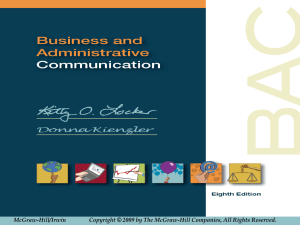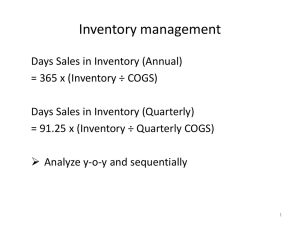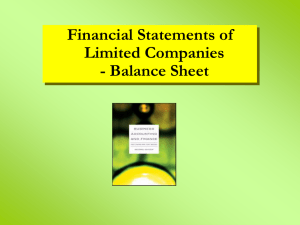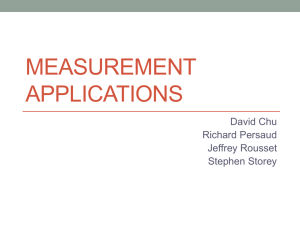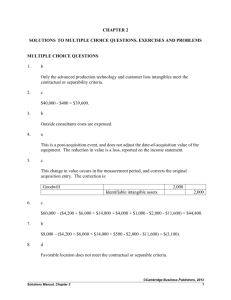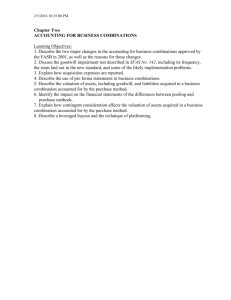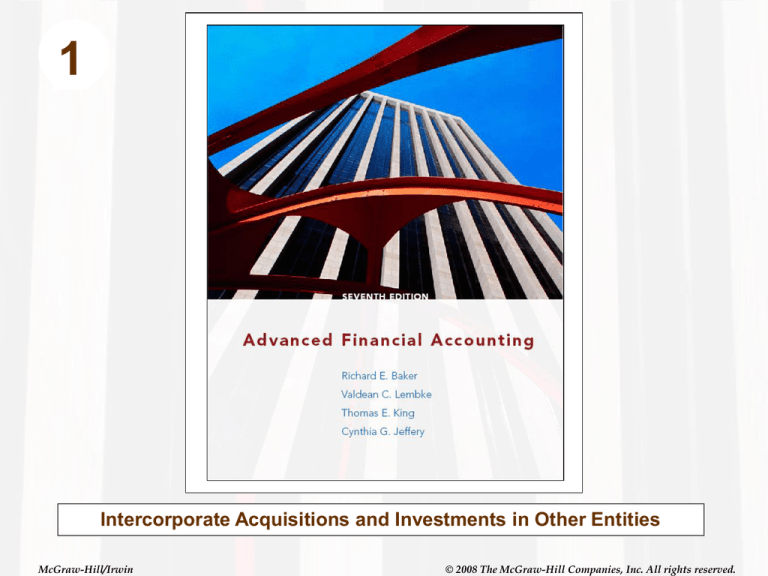
1
Intercorporate Acquisitions and Investments in Other Entities
McGraw-Hill/Irwin
© 2008 The McGraw-Hill Companies, Inc. All rights reserved.
1-2
Intercorporate Acquisitions and
Investments in Other Entities
This chapter provides an overview of complex
organizational arrangements (or structures).
• Complex organization structures often result from
complex business strategies such as:
• Extending operations into foreign countries.
• Initiating new product lines.
• Separating activities that fall under regulatory
controls.
• Reducing taxes by separating certain types of
operations.
1-3
Intercorporate Acquisitions and
Investments in Other Entities
•
Several accounting transactions may be required
to initiate a complex organization structure.
•
There is a need to analyze multiple transactions for
multiple companies simultaneously—not just one
transaction for one company.
1-4
Intercorporate Acquisitions and
Investments in Other Entities
The accounting procedures in this chapter
are driven by such questions as:
• Did the company acquire the common stock of
another company or the assets of another
company ?
• Was the company dissolved (i.e. liquidated) or
did the company continue to exist?
• Was a new company formed?
• Was there a change in ownership control?
• Is the acquired company wholly-owned?
1-5
Forms of Business Combinations
• There are three primary forms of business
combinations:
• Statutory Merger
• Statutory Consolidation
• Stock Acquisition
1-6
Statutory Merger
• A statutory merger occurs when one company
acquires another company and the assets and
liabilities of the acquired company are transferred to
the acquiring company.
• In a statutory merger, the acquired company is
liquidated and the acquiring company continues to
exist.
1-7
Statutory Consolidation
• A statutory consolidation occurs when a new
company is formed to acquire the assets and
liabilities of two combining company.
• In a statutory consolidation, the combining
companies are dissolved and the new company is
the only surviving entity.
1-8
Stock Acquisition
• A stock acquisition occurs when one company
acquires a majority of the common stock of another
company and the acquired company is not
liquidated.
• In a stock acquisition, both companies continue to
operate as separate but related corporations (i.e.,
affiliated corporations).
1-9
Stock Acquisition:
Parent-Subsidiary Relationship
• A subsidiary is a corporation that is controlled
(through common stock ownership) by another
corporation, that is, the parent corporation.
• Controlling Interest: The parent owns a
majority of the common stock of the
subsidiary.
• Wholly-Owned Subsidiary: The parent owns
all of the common stock of the subsidiary.
• Given that a subsidiary is a separate legal entity, the
parent’s risk associated with the subsidiary’s
activities is limited.
1-10
Methods of Effecting Business Combinations
• Business combinations can be either friendly or
unfriendly.
– Friendly combinations involve both management
teams and recommend approval by the
stockholders
– Unfriendly combinations are known as ‘hostile
takeovers’ where the acquiring company makes a
direct tender offer to the stockholders.
1-11
Valuation of Business Entities
• Assessing the overall value of a company often
includes:
• Valuation of Individual Assets and Liabilities
• Valuation of Potential Earnings
• Valuation of Consideration Exchanged
1-12
Valuation of Individual
Assets and Liabilities
• The value of a company’s individual assets is
usually determined by appraisal.
• Current liabilities are often viewed as having fair
values equal to their book values because they will
be paid at face amount within a short time.
• Long-term liabilities must be valued based on
current interest rates if different from the effective
rates at the issue dates of the liabilities.
• Tax aspects must also be considered.
1-13
Valuation of Potential Earnings
• Synergy occurs when assets operated together
have a value that exceeds the sum of their individual
values.
• This “value” makes it desirable to operate assets
jointly rather than sell them individually.
• Possible approaches to measuring the value of a
company’s future earnings include:
• Multiples of current earnings.
• Present value of anticipated future new
cash flows generated by the company.
• Sophisticated financial models.
1-14
Valuation of Consideration Exchanged
• When one company acquires another, a value must
be placed on the consideration given in the
exchange.
• Little difficulty is encountered when cash is used in
an acquisition, but valuation may be more difficult
when securities are exchange, particularly illiquid or
privately held securities or securities with unusual
features (e.g., convertible or callable securities).
1-15
Purchase Method (Current GAAP)
• The central idea underlying the purchase method is
the same idea underlying the purchase of any asset
or group of assets: there is a change in ownership
control.
• That is, since there is a change in ownership control,
the purchaser’s accounting is based on the fair
value of the assets and liabilities: not the seller’s
book values.
1-16
Pooling Method (Not Current GAAP)
• The central idea underlying the pooling method was
opposite that of the purchase method—a continuity
of interest.
• That is, the owners of the combining companies
became the owners of the combined company.
• Thus, the book values of both companies were
carried forward since there was not a change in
ownership control (i.e., there was no arm’s length
transaction to determine a “fair” fair value).
1-17
Chapter 1 Important Terms
– Cost of Investment (Purchase Price)
– Goodwill – when the purchase price exceeds FV of
identifiable assets & liabilities
– Fair Value – amount needed to buy an asset or refinance a
liability today
– Book Value – historical cost or monetary amount owed for
liabilities (adjusted for premium or discounts)
– Identifiable Assets – assets other than goodwill
– Identifiable Liabilities – known liabilities
– Net Identifiable Assets – net identifiable assets less net
identifiable liabilities
– Differential: difference between cost of the investment and
book value of the net identifiable assets.
1-18
Cost of Investment (Purchase Price)
• The value of the consideration given to the owners
of the acquired company normally constitutes the
largest part of the total cost.
• There are three types of other costs that may be
incurred in effecting a business combination:
• Direct costs
• Costs of issuing securities
• Indirect and general costs
1-19
Purchase Price
--Direct Costs
• All direct costs associated with purchasing another
company are capitalized as part of the total cost of
the acquired company.
• Examples:
• Finders’ fees
• Accounting fees
• Legal fees
• Appraisal fees
1-20
Purchase Price
--Costs of Issuing Securities
• Costs incurred in issuing equity securities in
connection with the purchase of a company should
be treated as a reduction in Additional-Paid-In
Capital. Examples include: Listing fees; Audit and
legal fees related to the registration; and, Brokers’
commissions.
• Costs incurred in issuing bonds payable in
connection with the purchase of a company should
be accounted for as bond issue costs and amortized
over the term of the bonds.
1-21
Purchase Price
--Indirect and General Costs
• All indirect and general costs related to a business
combination or to the issuance of securities in a
combination should be expensed as incurred.
• For example, the salary costs of accountants on the
staff of the acquiring company in a business
combination would be expensed, even though some
of their time was spent on matters related to the
combination.
1-22
Goodwill
• Any amount of the purchase price in excess of the
fair value of the identifiable assets and liabilities
acquired is viewed as the price paid for goodwill.
• In theory, goodwill is the excess earnings power of
the of the acquired company.
• In practice, goodwill represents the premium paid to
acquire control.
1-23
Example of Calculating Goodwill
Parent estimates Sub will earn $824,000 next
year
Companies similar to Sub Co. earned $532,000
last year
Parent requires a 15% rate of return on this
investment
Parent assumes excess earnings will continue
for seven years
1-24
IMPLIED GOODWILL CALCULATION
SUB'S ESTIMATED ANNUAL EARNINGS
$824,000
LESS: NORMAL FOR INDUSTRY
532,000
292,000
PRESENT VALUE FACTOR
(7 YEARS, 15%, ORDINARY ANNUITY)
4.16042
IMPLIED GOODWILL
$1,214,843
1-25
Subsequent Accounting for
Goodwill
• Goodwill is carried forward to subsequent
accounting periods at the original amount, without
amortization, unless it becomes impaired.
• Goodwill must be evaluated for impairment at least
annually, at the same time each year, and more
frequently if events occur that are likely to impair the
value of goodwill.
1-26
Bargain Purchase Price
(a.k.a. Negative Goodwill)
• Negative goodwill is said to exist when a purchaser
pays less than the fair value of the identifiable net
assets of another company in acquiring its
ownership.
• Negative goodwill is to be used to reduce the
amounts that otherwise would have been assigned
to the acquired assets except financial assets other
than equity-method investments, assets to be sold,
deferred tax assets, prepaid benefit assets and
other current assets.
1-27
Additional Thoughts
• The selling company would have recorded a
“GAIN ON SALE” if their net assets would
have been sold for an amount greater than
book value or “LOSS ON SALE” if their net
assets would have been sold for an amount
less than book value.
• The purchasing company records the various
assets and liabilities at their individual FAIR
VALUE (not book value).
1-28
Example: Combination Effected
through Purchase of Net Assets
• Point acquires the all of the common stock of Sharp
issuing the shareholders of Sharp 10,000 shares of $10
par common stock. The shares have a total market
value of $600,000.
• Sharp continues to operate as a separate entity after the
business combination transaction.
• Point incurs $40,000 in legal and appraisal fees and
$25,000 in stock issuance costs.
• FMV of net assets are 510,000 Broken down as follows:
(A/R 45K: Inv 75K: PPE 420K Patent 80K:Liab 110K)
1-29
Example: Combination Effected
through Purchase of Net Assets (Cont’d.)
Entries Recorded By Acquiring Company (Point)
Deferred Merger Costs
$40,000
Deferred stock Issue Costs $25,000
Cash
$65,000
1-30
Example: Combination Effected
through Purchase of Net Assets (Cont’d.)
• Entries Recorded By Acquiring Company (Point).
Cash and Receivables
Inventory
Land, Buildings and Equipment
Patent
Goodwill
Current Liabilities
Common Stock
Additional Paid-In Capital
Deferred Merger Costs
Deferred Stock Issue Costs
$45,000 #
75,000 #
420,000 #
80,000 #
130,000 *
$110,000 #
100,000
475,000
40,000 **
25,000 **
* See next slide. **See previous two slides. # Fair Market Value
1-31
Example: Combination Effected
through Purchase of Net Assets (Cont’d.)
• Calculation of Goodwill
• Investment Cost:
Fair value of stock issued
PLUS: Other acquisition costs
Total purchase price
• LESS:
Book value of net assets
• Differential
$600,000
40,000
$640,000
510,000
$130,000
In this case the differential all relates to goodwill since BV = FV for all the
assets.
1-32
Example: Combination Effected
through Purchase of Net Assets (Cont’d.)
Entries Recorded By Acquired Company (Sharp).
Investment in Point Stock $600,000
Current Liabilities
100,000
Accumulated Depreciation
150,000
Cash and Receivables
$45,000
Inventory
65,000
Land
40,000
Buildings and Equipment
400,000
Gain on sale of Net Assets
300,000
1-33
Example: Combination Effected
through Purchase of Stock
• Point acquires the all of the common stock of Sharp
issuing the shareholders of Sharp 10,000 shares of $10
par common stock. The shares have a total market
value of $600,000.
• Sharp continues to operate as a separate entity after the
business combination transaction.
• Point incurs $40,000 in legal and appraisal fees and
$25,000 in stock issuance costs.
• FMV of net assets are 510,000 Broken down as follows:
(A/R 45K: Inv 75K: PPE 420K Patent 80K:Liab 110K)
1-34
Example: Combination Effected
through Purchase of Stock
• Entries Recorded By Acquiring Company
(Point)
Deferred Merger Costs
$40,000
Deferred Stock Issue Costs $25,000
Cash
$65,000
1-35
Example: Combination Effected
through Purchase of Stock (Cont’d.)
• Entries Recorded By Acquiring Company (Point)
Investment in Sharp Stock
$640,000 *
Common Stock
$100,000
Additional Paid-In Capital
475,000
Deferred Merger Costs
40,000
Deferred Stock Issue Costs
25,000
$640,000 = $600,000 Fair Value + $40,000 Merger Costs
$475,000 = ($50*10,000 shares) - $25,000 Stock Issue Costs
$100,000 = ($10 par *10,000 shares)
1-36
Financial Reporting
Subsequent to a Purchase
• When a combination occurs during a fiscal year,
income earned by the acquired company prior to the
combination is not reported in the income statement
of the combined entity.
• If the combined entity reports comparative financial
statements that include statements for periods
before the combination, those statements include
only the activities and financial statements of the
acquiring company and not those of the acquired
company.
1-37
Disclosure Requirements
(a.k.a. Notes to the Financial Statements)
• A number of disclosures are required to provide financial
statement readers with information about the combination:
• A description of the acquired entity.
• The percentage voting interests acquired.
• The primary reason for the acquisition.
• A description of the factors that contributed
to the recognition of goodwill.
• Contingent payments, options, or commitments.
• Purchased research and development assets acquired
and written off.




